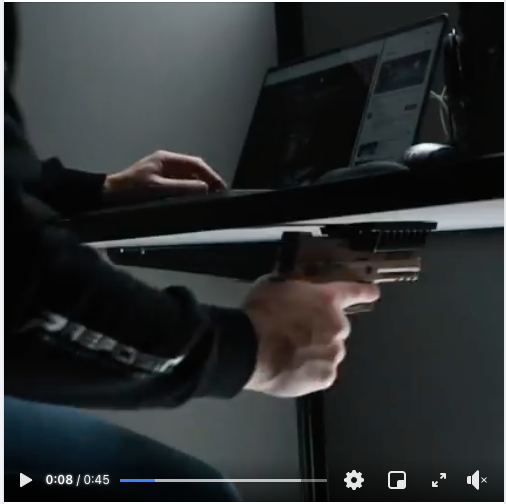These things have been popping up in a Facebook feed near you, and a very one sided advertising portrayal makes them seem handy, but they are a horrible idea under almost all circumstances.
“You gun is always somewhere”
This phrase is an important part of safe staging and storage rules. It is a reminder that once you leave the firearm in a spot, that it remains in existence even if you walk away. That means that the spot you leave it in is important, and as the firearm’s owner it is YOUR responsibility to ensure that access to that firearm is controlled.
The advertisements show these magnets left in various places, presumably to be readily accessed in a time of need. But what about their access at all other times? This thing isn’t a safe. It isn’t on you. Not on you and unconstrained access to it? No thanks.
Reducing administrative handling
Administrative handling is the handling of the firearm in an other-than-time-of-use. When you get dressed for the day and strap your pistol/holster to your belt, that is an administrative handling. Likewise when you go to bed at night. Ideally, these are the only two administrative handlings one does each day.
But we don’t live in a perfect world when it comes to our rights. Going to the post office? You need to disarm. Does your state have various pistol-free zones? You may need to disarm. Is your workplace a non-permissive environment? Another disarm opportunity.
When we disarm, ideally we are doing so with the holster, so that the firearm trigger mechanism remains covered. It is a small assurance and good administrative practice, and does NOT imply that we do not know how to handle the firearm, but rather that we understand its operation and include one additional precaution in safe handling.
The manufacturers of this magnet apparently believe that administrative handling is the business of the day. Going to the kitchen to get a coffee? Unholster that pistol and put it in the mount. Settling down to work for the day? Unholster and mount it to your desk. Driving around? You guessed it… unholster and stick it to the dash. What they don’t show is that EVERY administrative handling comes with a Buy One Get One Free reholstering, and each time you change locations, you have to perform another administrative handling putting it back in your holster.
If you remember to do so.
Yup. Imagine accidentally leaving that pistol in its magnet at work after you’ve gone home for the day. If you’re responsible, you’ll drive back in and get it immediately. If you’re wise, you’d never put yourself in that position to begin with.

More draw strokes make more inconsistency
Ideally we train our draw stroke regularly. Private ranges don’t always allow it, but with some classes and finding the range that knows you are responsible and vigilant owner and not a selfies-with-guns-in-my-bedroom owner, you can get more leeway to train.
Also ideally a person should train to get their gun to bear on target from any position, with the gun in any position. Laying in bed with the gun next to you. In the car with the gun at your side. Sitting on the couch watching The Mandalorian. The permutations become staggering. But, this is the way.
In reality we practice a few different draw strokes. Laying down and night stand. Standing and OWB (outside the waistbelt) strong side. Determining what sitting in a vehicle or at our desk requires to modify that. Maybe an additional carry option such as a shoulder holster (lefties making long road trips: look into this!).
Practicing these “most of the time” draw strokes helps us to develop the procedural memory so that the draw is as speedy as any other natural movement. If one’s training time is not infinite, then it makes sense to carry the firearm in a manner to reduce different draw strokes, so that the training you can do is as relevant to as many situations as possible.
These gun magnets introduce more combinations. Where are they mounted? How do you get to them? What position do you need to be in to pull the pistol effectively? What angle are they at?

This one is especially humorous. You’re in your office hard at work on your TPS reports… Bad Guy comes in, unhinged, muttering about a stapler, and threatens to burn the building down. Let’s look at two different scenarios.
You have your pistol in a holster:
- You look up and assess Bad Guy is a life threatening event.
- Your hands stay in your workspace and in front of you.
- You are ABLE to stay seated or move backwards in the chair to stand up.
- Whichever you decide, the gun is on YOU in a holster.
- You use a draw stroke you’ve practiced numerous times.
- Draw, deploy, threat handled.
You have your pistol in a magnet:
- You look up and assess Bad Guy is a life threatening event.
- Your hand MUST go from the top of the desk to under the desk. If the fight turns physical your hand is not in immediate play.
- You MUST stay seated to access the firearm. If you stand, you must now stay leaning forward to reach down to retrieve the magnet-held firearm. Vitals-forward isn’t a great choice…
- You use a draw stroke you have likely not trained with as extensively as your CPL-intent draw stroke.
- You are finally able to to stand up, and MUST move backwards to get the gun up and around the table. (I concede you may be able to make a Han vs Greedo undertable shot, but a pistol isn’t a blaster and I’d much rather have the ability to hit vitals with my bullets because I don’t have an energy gun).
- Draw, deploy, threat handled… later.
Conclusion
There may be some benefits to the magnet mount. They will be situational at best. They will certainly not be the clever, versatile mounting system their advertisement portrays, nor is the scenarios portrayed useful in common real life application that they are portrayed in.
Verdict:
Worst case: Things that will get you killed.
Best Case: Meme tiered trash

